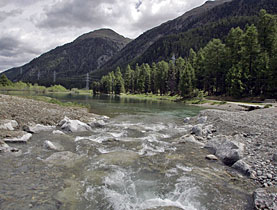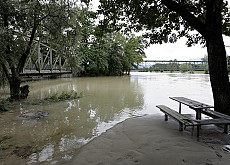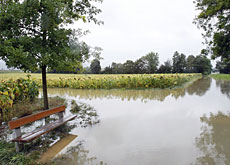Public supports river naturalisation

Swiss rivers and streams should be restored to their natural state, according to an opinion poll.
The Swiss Fisheries Federation, which commissioned the survey and is backing a people’s initiative demanding change, claims 90 per cent of rivers are obstructed, channelled or influenced by power plants.
The poll carried out by the gfs Zurich institute found that almost 80 per cent of people supported moves to restore the natural condition of watercourses, the federation said in a statement on Sunday.
“It means that we are on the right track with the initiative,” Otto Sieber, central secretary at Pro Natura, told swissinfo.
The conservation group, together with the Swiss Fisheries Federation, WWF Switzerland and Aqua Viva, handed in an initiative in July 2006. It was signed by some 160,000 people – 60,000 more than the minimum required to force a nationwide vote, a vote that should take place next year.
The campaigners are unimpressed by the current water protection law introduced 15 years ago. They claim all major Swiss rivers have been adjusted or held back, and one in five watercourses has been buried and disappeared from the landscape.
They accuse hydroelectric power plants of causing harmful variations in water levels, opening and shutting the sluice gates to many watercourses in the sole pursuit of profits.
“The law was much improved in the 1990s but only for new projects, so all hydroelectric plants with long concessions don’t have to change anything,” complained Sieber.
The Fisheries Federation says that fish stocks are under threat, especially from artificial river barriers which block access to natural breeding areas.
Who’s to pay?
As well as cleaning up rivers, the campaigners also want the creation of cantonal funds to pay for landscape restoration work.
The Swiss cabinet has rejected the initiative, saying it goes too far and will impinge on hydropower production – around 60 per cent of overall electricity produced. But parliament is considering a counter-proposal ahead of the vote.
“The details of how far they go and where the money comes from are the two crucial questions,” said Sieber.
In December the House of Representatives gave its support to a Senate motion proposing a 0.1-centime additional tax per kilowatt-hour of electricity produced to finance the restoration projects.
A Senate environment commission is due to discuss the subject on Thursday.
Another area outlined in the initiative is the right to take local authorities to court if they violate water protection laws.
“There are some cantons that haven’t done a thing for 15 years – that’s why we need an initiative,” said Werner Widmer from the Swiss Fisheries Federation.
Swiss watercourses came under the spotlight last summer after bad storms and flooding – the country’s worst for two years – left large parts of northwestern Switzerland and low-lying areas under water.
Andreas Knutti, a water expert with WWF Switzerland, criticised the country’s flood protection methods.
Knutti told swissinfo that as corseted Swiss rivers no longer have enough room, fast-rising floodwaters have nowhere to run off. He added there was a “lack of political will and money” to implement proper natural protection measures.
swissinfo, Simon Bradley
The poll was carried out at the end of November and beginning of December.
Just over 1,000 people in German- and French-speaking areas of Switzerland were questioned.
Only three per cent said they did not support the restoration of natural waterways at all.
The 2007 poll showed an increase in support over 2004, when respondents were asked the same question.
Numerous rivers and streams dry up periodically as a result of water withdrawals. Since 1992, legal requirements have existed concerning the minimum amounts of water – or residual flow – to be maintained downstream of a withdrawal site.
Over-harnessing of water upstream is thought to dry up rivers and have a harmful effect on plants and wildlife.
Switzerland has one of the most diverse plant and wildlife habitats in Europe. Over the past 150 years, 224 species of plants and animals have disappeared.
Eight of the 57 original fish species found in Switzerland are now extinct and 37 are endangered.
Switzerland currently produces some 40% of its electricity from five nuclear power reactors while most of the rest comes from hydropower.

In compliance with the JTI standards
More: SWI swissinfo.ch certified by the Journalism Trust Initiative




You can find an overview of ongoing debates with our journalists here. Please join us!
If you want to start a conversation about a topic raised in this article or want to report factual errors, email us at english@swissinfo.ch.